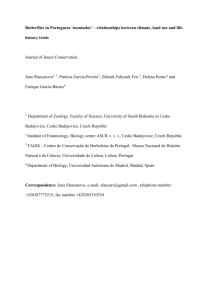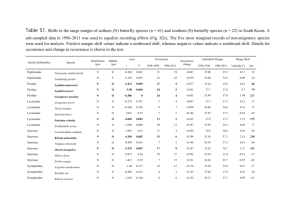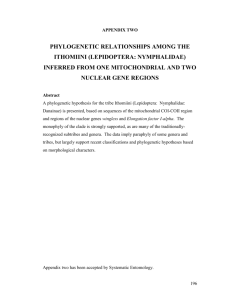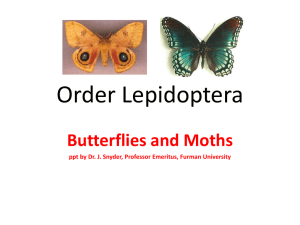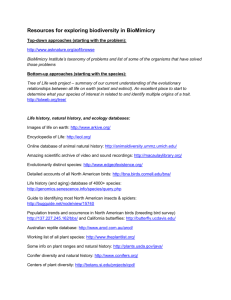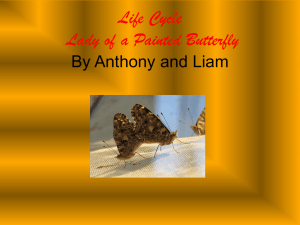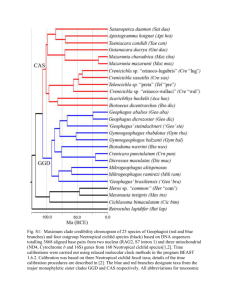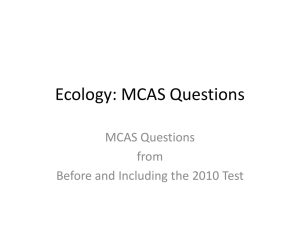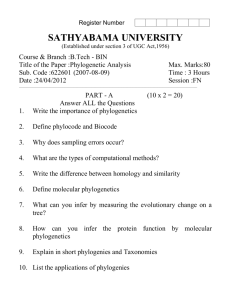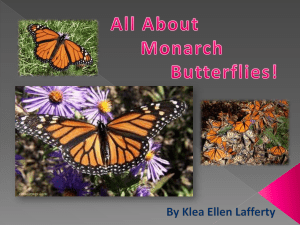jbi12330-sup-0001-AppendixS1
advertisement
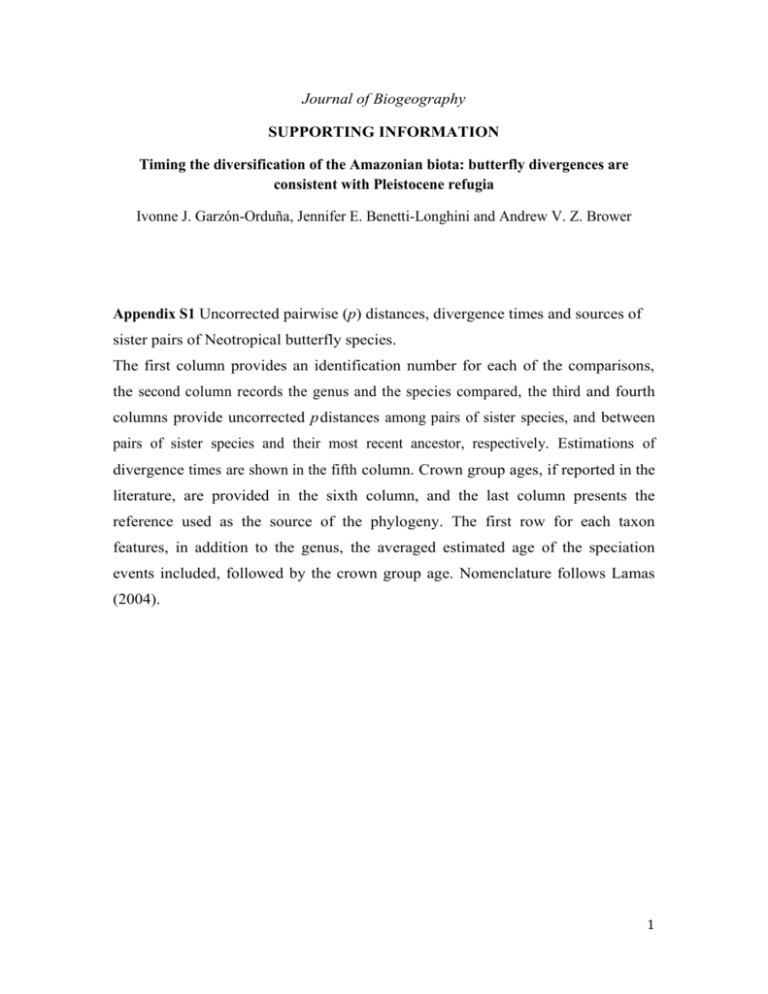
Journal of Biogeography SUPPORTING INFORMATION Timing the diversification of the Amazonian biota: butterfly divergences are consistent with Pleistocene refugia Ivonne J. Garzón-Orduña, Jennifer E. Benetti-Longhini and Andrew V. Z. Brower Appendix S1 Uncorrected pairwise (p) distances, divergence times and sources of sister pairs of Neotropical butterfly species. The first column provides an identification number for each of the comparisons, the second column records the genus and the species compared, the third and fourth columns provide uncorrected p distances among pairs of sister species, and between pairs of sister species and their most recent ancestor, respectively. Estimations of divergence times are shown in the fifth column. Crown group ages, if reported in the literature, are provided in the sixth column, and the last column presents the reference used as the source of the phylogeny. The first row for each taxon features, in addition to the genus, the averaged estimated age of the speciation events included, followed by the crown group age. Nomenclature follows Lamas (2004). 1 Estimated age (Ma) Species pair compared p distance among sister taxa p distance between three taxa* Brower (1994) 1.1% Myr –1 Nymphalidae: Danaine FORBESTRA 1 2 3 4 5 6 7 8 9 olivencia–proceris 1–equicola HYALIRIS 0.002 antea–oulita HYPOSCADA 0.013 zarepha–anchiala schausi–virginiana 5–kena HYPOTHYRIS 0.034 0.034 ninonia–mansuetus 7–mamercus ITHOMIA 0.027 lagusa–xenos 0.038 0.051 0.036 0.025 Crown group age reported in literature (Ma) Source of phylogeny c. 6.40 Elias et al. (2007) c. 6.00 Arias-Mejia (2012) 0.09 2.32 0.59 1.57 Not available 1.55 1.55 1.63 1.18 c. 7.00 1.23 1.14 1.11 3.00–8.00 de Silva et al. (2010) Arias-Mejia (2012) Mallarino et al. (2005) 1.73 2 10 11 12 13 14 15 16 17 18 19 20 21 22 23 24 25 26 27 28 29 30 31 32 33 34 35 iphianassa–salapia 10–cleora celemia–heraldica eleonora–ellara 13–praeithomia amarilla–arduinna 15–jucunda NAPEOGENES 0.004 glycera–N. species 1 17–pharo larina–aethra duessa–stella apulia–gracilis 21–inachia lycora–harbona sodalis–benigna 24–sulphureophila cranto–flossina OLERIA 0.040 aquata–sexmaculata tigilla–assimilis enania–quintina ilerdina–onega Oleria sp. nov 17–511 estella 31–gunilla rubescens–paula 33–zelica boyeri–deronda 0.062 0.050 0.056 0.060 0.022 0.033 0.031 0.003 0.018 0.031 0.038 0.042 0.050 0.037 0.008 0.017 0.046 0.021 0.064 0.070 0.039 0.025 0.033 0.063 0.18 1.50 1.41 0.14 0.82 1.41 1.73 1.80 c. 13.00 1.82 1.91 2.27 1.68 0.36 0.77 2.09 0.95 2.91 3.18 2.05 Not available Elias et al. (2009) de Silva et al. (2010) 2.82 2.27 2.55 2.73 1.00 1.77 1.14 1.50 2.86 3 36 37 38 39 40 41 42 43 44 35–derondina radina–baizana santineza–fumata athalina–fasciata attalia–cyrene 40–bioculata tremona–makrena makrena–padilla TITHOREA† 0.063 0.023 0.034 0.065 0.052 0.068 0.031 0.022 harmonia–tarricina 0.098 Nymphalidae:Satyrinae BLEPOLENIS 45 46 2.86 1.05 1.55 2.95 2.36 3.09 1.41 1.00 catherinae–batea 45– bassus DASYOPHTHALMA 0.010 rusina–geraensis 47–creusa FORSTERINARIA SUBCLADE 0.055 49 50 51 52 53 54 antje–pseudinornata neonympha–inornata coipa–boliviana pilosa–pichita 52–guaniloi punctata–rotunda 0.026 0.041 0.027 0.046 0.043 1.18 1.86 1.23 2.09 2.59 1.95 55 Guaianaza pronophilina–F. necys 0.050 2.27 47 48 0.100 0.057 A. Zubek‡, unpublished data 15.00§ Penz et al. (2011) 4.45 0.68 0.020 Not available 0.45 0.91 3.52 2.50 4.55 1.88 Penz (2009) c. 10.00 Matos-Maravi et al. (2013) 4 HARJESIA 56 57 58 59 60 61 62 63 64 65 66 67 68 69 70 71 72 73 74 75 76 77 obscura–spp DNA99044 56– blanda LYMANOPODA 0.013 acraeida–venosa caeruleata–caucana melia–tolima caracara–hazelana ionius–pieridina excisa–nivea labda–nadia araneola–hockingi dietzi–lecromi confusa–obsoleta albomaculata–apulia 68–affineola MORPHO 0.050 0.038 0.062 0.071 0.034 0.042 0.059 0.027 0.033 0.031 0.031 amathonte–menelaus achilles–helenor 71–granadensis deidamia–epistrophus cisseis–hecuba hercules–theseus rhetenor–cypris marcus–eugenia 0.064 0.029 0.067 0.029 0.072 0.067 0.063 0.058 0.053 0.036 1.82 c. 7.00 Matos-Maravi et al. (2013) 0.59 3.05 1.92 c. 27.00 Casner & Pyrcz et al. (2010) 2.27 1.73 2.82 3.23 1.55 1.91 2.68 1.23 1.50 1.41 1.41 1.32 2.51 c. 20.00 Penz et al. (2012) 2.91 1.32 3.27 3.05 2.86 2.64 2.41 1.64 5 Not available ORESSINOMA 78 sorata–typhla PARATAYGETIS 0.065 lineata–albinotata PSEUDODEBIS SUBCLADE 0.050 80 Taygomorpha celia–T. puritana 0.043 81 80–Pseudodebis marpessa TAYGETIS 79 82 83 84 85 86 87 88 89 90 91 92 93 94 Kodandaramaiah et al. (2010) 2.95 Matos-Maravi et al. (2013) 2.27 2.70 0.060 banghaasi–Harjesia oreba Taygetis kerea–coeruleotaygetis peribaea 93–Taygetis weymeri 0.072 0.073 Matos-Maravi et al. (2013) 3.45 1.78 c. 7.50 Matos-Maravi et al. (2013) 2.73 2.50 2.77 2.05 2.00 1.23 1.41 1.18 0.91 1.00 3.30 c. 9.00 Matos-Maravi et al. (2013) 1.95 0.076 mermeria–larua 82–Taygetis sp. PM01-14 tripunctata–nr virgilia rufomarginata–virgilia 85–acuta echo–Taygetis sp. PM01-06 thamyra–sosis 88–Taygetis sp. PM04-04 uncinata–Taygetis sp. UNO261 90–laches TAYGETINA SUBCLADE c. 8.00 0.055 0.061 0.045 0.044 0.027 0.031 0.026 0.020 0.022 3.27 3.32 0.073 3.32 6 Nymphalidae: Charaxinae ARCHEOPREPONA+ NOREPPA 95 96 97 98 99 100 101 102 103 104 105 106 107 108 109 110 2.89 demophon–camilla 95–phaedra licomedes–chromus meander–amphimachus 98–chalciope CONSUL 0.054 fabius–panariste 100–electra PREPONA–AGRIAS 0.010 amydon–hewitsonius praeneste–deiphile neoterpe pylene–deiphile ibarra A. claudina–A. narcissus Nymphalidae: Nymphalinae BAEOTUS 0.021 0.027 0.055 0.019 aelius–beotus 106–deucalion ERESIA 0.067 eunice–nauplius carme–polina 109–emerantia 0.055 0.032 0.081 0.064 0.022 0.097 0.049 Not available Ortiz-Acevedo & Willmott (2013) Not available Inferred from taxonomy Not available Ortiz-Acevedo & Willmott (2013) 2.45 3.68 2.91 1.00 4.41 0.45 2.23 1.39 0.95 1.23 2.50 0.86 Inferred from taxonomy 3.55 0.089 0.043 3.05 4.05 1.80 c. 15.00 Wahlberg & Freitas (2007) 2.50 1.45 1.95 7 111 112 113 114 115 116 117 118 119 120 121 122 123 124 125 126 perna–clio 111–letitia casiphia–stricta 113–datis GNATHOTRICHE 0.034 exclamationis–mundina HYPANARTIA 0.011 lethe–godmanii 116–bella HISTORIS 0.033 odius–acheronta JANATELLA 0.088 leucodesma–hera 119–fellula JUNONIA 0.023 vestina–genoveva 121–evarete/coenia Nymphalidae: Biblidinae HAMADRYAS 0.024 epinome–iphthime belladonna–amphinome 124–arinome laodamia–velutina¶ 0.057 0.032 0.039 0.038 0.036 1.55 1.77 1.73 1.64 5.00 2.20 0.064 c. 16.00 Wahlberg & Freitas (2007) Not available Willmot et al. (2001) 1.50 2.91 Inferred from taxonomy 0.040 0.041 4.00 1.43 c. 10.00 Wahlberg & Freitas (2007) 1.05 1.82 1.48 Not available Pfeiler et al. (2012) c. 23.00 (95% HPD 20–27.5) Garzón Orduña et al. (2013) 1.09 1.86 1.67 0.026 0.032 2.59 1.45 1.18 1.45 8 PERISAMA 127 128 129 130 131 132 133 134 135 136 137 138 139 140 141 142 albipennis–bomplandii 127–moronina ambatensis–phenix latimargo–calamis klugii–dorbignyi alicia–paralicia goeringi–tryphena 133–affinis guerini–humboldti 135–comnena vitringa–cabirnia 137–yeba philinus–tristrigosa 139–canoma hazama–ouma Orophila cecidas–O.diotima 0.70 0.007 0.023 0.006 0.011 0.008 0.022 0.010 0.015 0.003 0.009 0.004 0.013 0.020 0.035 0.026 0.033 Nymphalidae: Heliconiinae EUEIDES 143 144 145 146 147 148 lybia–tales 143–aliphera lineata–isabella†† vibilia–lampeto 146–pavana HELICONIUS 0.077 charitonia–peruvianus 0.037 0.076 0.061 0.025 0.026 Not available A. Zubek‡, unpublished data 0.32 1.05 0.27 0.50 0.36 1.00 0.45 0.68 0.14 0.41 0.18 0.59 0.91 1.59 1.18 1.50 2.41 c. 18.4** Beltrán et al. (2007) 3.50 3.45 2.77 1.14 1.18 2.29 c. 18.4** Beltrán et al. (2007) 1.68 9 149 150 151 152 153 154 155 156 157 158 159 160 161 162 163 164 165 166 167 168 169 170 171 172 173 174 175 sara–leucadia eleuchia–congener 150–sapho clysonimus–telesiphe 152–hortense hierax–xanthocles 154–doris‡‡ burneyi–wallacei 156–egeria ethilla–nattereri hecale–atthis elevatus–pardalinus numata–ismenius melpomene–cydno§§ demeter–eratosignis Nymphalidae: Limenitidinae ADELPHA 0.059 0.053 justina–olynthia jordani–naxia 165–malea aethalia erotia–lycorias 167–phylaca mesentina–thesprotia irmin–leucophthalma 170–cocala rothschildi–sichaeus iphicleola–iphiclus 173–thessalia epione–ethelda 0.052 0.009 0.077 0.058 0.064 0.073 0.086 0.035 0.059 0.035 0.009 0.015 0.037 0.049 0.061 2.68 2.41 3.50 2.64 2.91 3.32 3.91 1.59 2.68 1.59 0.41 0.68 1.68 2.23 2.77 1.97 0.100 0.031 0.042 0.021 0.033 0.070 0.038 0.015 0.039 0.030 c. 11.00 Mullen et al. (2011) 2.36 0.41 4.55 1.41 1.91 0.95 1.50 3.18 1.73 0.68 1.77 1.36 10 176 177 178 179 180 181 182 183 184 185 186 187 cytherea–salmoneous Papilionidae: Troidina PARIDES–EURYADES 0.082 ascanius–buchinus proneus–agavus aeneas–tros panthonus–burchellanus 180–lysander eurimedes–zacynthus 182–neophilus childrenae–sesostris erithalion–vertumnus 185–anchises E. corethrus–E. duponchelii 0.040 0.089 0.070 0.020 3.73 2.20 0.031 0.026 0.047 0.076 0.028 0.045 0.061 c. 27.00 (95% HPD 23–32.4) Condamine et al. (2012) 1.82 4.05 3.18 0.91 1.41 1.18 2.14 3.45 1.27 2.05 2.77 *In a comparison ((A,B),C) the largest distance between A–C and B–C is reported. †Not sister taxa; there is a new species described from Colombia more closely related to T. harmonia from which there is not COI available yet (Willmott & Lamas, 2004). ‡Zoological Museum of the Institute of Zoology, Jagiellonian University, Kraków, Poland. §Species diversification reported to be around 2.5 Ma. ¶The sister pair is probably laodamia–arete but there is not COI for arete. **Time of divergence of Heliconius and Eueides. ††There might be two other species in between these two taxa, according to Beltran et al. (2007). ‡‡The largest distance is between doris and hierax, but hierax is a long branch. §§Largest divergence between races of melpomene and cydno. 11 REFERENCES Arias-Mejia, C.F. (2012) Patterns of diversification in Neotropical butterflies. PhD Thesis, McGill University, Montreal. Beltrán, M., Jiggins, C.D., Brower, A.V.Z., Bermingham, E. & Mallet, M. (2007) Do pollen feeding, pupal–mating and larval gregariousness have a single origin in Heliconius butterflies? Inferences from multilocus DNA sequence data. Biological Journal of the Linnean Society, 92, 221–239. Brower, A.V.Z. (1994) Rapid morphological radiation and convergence among races of the butterfly Heliconius erato inferred from patterns of mitochondrial DNA evolution. Proceedings of the National Academy of Sciences USA, 91, 6491–6495. Casner, K.L. & Pyrcz, T. (2010) Patterns and timing of diversification in a tropical montane butterfly genus, Lymanopoda (Nymphalidae, Satyrinae). Ecography, 33, 251– 259. Condamine, F.L., Silva–Brandao, K.L., Kergoat, G.J. & Sperling, F.A.H. (2012) Biogeographic and diversification patterns of Neotropical Troidini butterflies (Papilionidae) support a museum model of diversity dynamics for Amazonia. BMC Evolutionary Biology, 12, 82. Elias, M., Hill, R.I., Willmott, K.R., Dasmahapatra, K.K., Brower, A.V.Z., Mallet, J. & Jiggins, C.D. (2007) Limited performance of DNA barcoding in a diverse community of tropical butterflies. Proceedings of the Royal Society B: Biological Sciences, 274, 2881–2889. Elias, M., Joron, M., Willmott, K., Silva–Brandao, K.L., Kaiser, V., Arias, C.F., Gomez Piñerez, L.M., Uribe, S., Brower, A.V.Z., Freitas, A.V.L. & Jiggins, C.D. (2009) Out of the Andes: patterns of diversification in clearwing butterflies. Molecular Ecology, 18, 1716– 1729. Garzón–Orduña, I.J., Marini–Filho, O., Johnson, S.G. & Penz, C.M. (2013) Phylogenetic analysis of Hamadryas (Nymphalidae: Biblidinae) based on the combined analysis of morphological and molecular data. Cladistics, 29, 629–642. Kodandaramaiah, U., Peña, C., Brady, M., Grund, R., Muller, C.J., Nylin, S. & Wahlberg, N. (2010) Phylogenetics of Coenonymphina (Nymphalidae: Satyrinae) and the problem of rooting rapid radiations. Molecular Phylogenetics and Evolution, 54, 386–394. Lamas, G. (ed.) (2004) Atlas of Neotropical Lepidoptera. Checklist: Part 4A Hesperioidea– Papiionoidea. Scientific Publishers/Association of Tropical Lepidoptera, Gainesville, FL. Mallarino, R., Bermingham, E., Willmot, K.R., Whinnett, A. & Jiggins, C.D. (2005) Molecular systematics of the butterfly genus Ithomia (Lepidoptera: Ithominae): a composite phylogenetic hypothesis based on seven genes. Molecular Phylogenetics and Evolution, 34, 625–644. Matos-Maravi, P.F., Peña, C., Willmot, K.R., Freitas, A.V.L. & Wahlberg, N. (2013) Systematics and evolutionary history of butterflies in the ‘Taygetis clade’ (Nymphalidae: Satyrinae: Euptychiina): towards a better understanding of Neotropical biogeography. Molecular Phylogenetics and Evolution, 66, 54–68. 12 Mullen, S.P., Savage, W.K., Wahlberg, N. & Willmot, K.R. (2011) Rapid diversification and not clade age explains high diversity in neotropical Adelpha butterflies. Proceedings of the Royal Society B: Biological Sciences, 278, 1777–1785. Ortiz–Acevedo, E. & Willmott, K.R. (2013) Molecular systematics of the butterfly tribe Preponini (Nymphalidae: Charaxinae). Systematic Entomology, 38, 440–449. Penz, C.M. (2009) Phylogeny of Dasyophthalma butterflies (Lepidoptera, Nymphalidae, Brassolini). Insecta Mundi, 69, 1–12. Penz, C.M., Mohammadi, N. & Wahlberg, N. (2011) Neotropical Blepolenis butterflies: wing pattern elements, phylogeny, and Pleistocene diversification (Lepidoptera: Nymphalidae). Zootaxa, 2897, 1–17. Penz, C.M., DeVries, P.J. & Wahlberg, N. (2012) Diversification of Morpho butterflies (Lepidoptera, Nymphalidae): a re–evaluation of morphological characters and new insight from DNA sequence data. Systematic Entomology, 37, 670–685. Pfeiler, E., Johnson, S. & Markow, T. A. (2012) DNA barcodes and insights into the relationships and systematics of buckeye butterflies (Nymphalidae: Nymphalinae: Junonia) from the Americas. Journal of the Lepidopteran Society, 66, 185–198. de– Silva, D.L., Day, J., Elias, M., Willmott, K., Whinnett, A. & Mallet, J. (2010) Molecular phylogenetics of the neotropical butterfly subtribe Oleriina. Molecular Phylogenetics and Evolution, 55, 1032–1041. Wahlberg, N. & Freitas, A.V.L. (2007) Colonization of and radiation in South America by butterflies in the subtribe Phyciodina (Lepidoptera: Nymphalidae). Molecular Phylogenetics and Evolution, 44, 1257–1272. Willmott, K.R. & Lamas, G. (2004) A new species of Tithorea (Lepidoptera: Nymphalidae: Ithomiinae) from the Choco Region of northwestern South America and Panama. Journal of the New York Entomological Society, 112, 1–17. Willmott, K.R, Hall, J.P.W. & Lamas, G. (2001) Systematics of Hypanartia (Lepidoptera: Nymphalidae: Nymphalinae), with a test for geographic speciation mechanisms in the Andes. Systematic Entomology, 26, 369–399. 13
